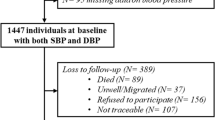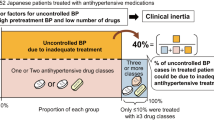Abstract
Hypertension in diabetes is an important and treatable cardiovascular risk factor. Treatment targets from guidelines cannot always be achieved in everyday clinical practice. It is therefore of great importance to monitor trends in hypertension control in defined populations. Patients with type I diabetes (range 6685–10 100; treated hypertension 21–29%) or with type II diabetes (range 15 935–22 605; treated hypertension 47–56%) were included in four national samples between 1996 and 1999. This screening was part of the procedures for the National Diabetes Register in Sweden, which monitors trends in clinical practice and risk factors for patients with diabetes, recruited both in primary health care and at the hospital level. A favourable trend in mean and median blood pressure levels was noticed during the 4-year study period, based either on data from repeated surveys or on repeated measures in the same individual, both for type I diabetes (mean: −2/−2 mmHg; P<0.01) and for type II diabetes (mean: −5/−3 mmHg; P<0.001). Correspondingly, the proportion of hypertensive patients in acceptable control of blood pressure (⩽140/85 mmHg) increased (P<0.001) both in type I diabetes (52.0–57.9%) and in type II diabetes (22.4–33.3%). It was concluded that hypertension is a widespread cardiovascular risk factor in patients with diabetes, especially systolic hypertension. A trend for a better systolic blood pressure control during the late 1990s in hypertensive patients with type II diabetes in Sweden could translate into substantial (estimated) clinical benefits in cardiovascular and diabetes-related morbidity. The National Diabetes Register makes a quality assessment of the hypertension treatment possible.
This is a preview of subscription content, access via your institution
Access options
Subscribe to this journal
Receive 12 digital issues and online access to articles
$119.00 per year
only $9.92 per issue
Buy this article
- Purchase on Springer Link
- Instant access to full article PDF
Prices may be subject to local taxes which are calculated during checkout
Similar content being viewed by others
References
Stamler J, Vaccaro O, Neaton JD, Wentworth D . Diabetes, other risk factors, and 12-yr cardio-vascular mortality for men screened in the Multiple Risk Factor Intervention Trial. Diabetes Care 1993; 16: 434–444.
Nordlund A et al. Cost of illness of adult diabetes mellitus underestimated if comorbidity is not con-sidered. J Intern Med 2001; 250: 57–65.
Prevention of coronary risk in clinical practice. Recommendations of the Second Joint Task Force of European and other Societies on Coronary Prevention. Summary of recommendations. Eur Heart J 1998; 19: 1434–1503.
Guidelines Subcommittee. World Health Organization–International Society of Hypertension guidelines for the management of hypertension. J Hypertens 1999; 17: 151–183.
Yudkin JS, Chaturvedi N . Developing risk stratification charts for diabetic and non-diabetic patients. Diabetic Med 1999; 16: 219–227.
The Sixth Report of the Joint National Committee on prevention, detection, evaluation, and treatment of high blood pressure. Arch Intern Med 1997; 157: 2413–2446.
Retinopathy and nephropathy in patients with type 1 diabetes four years after a trial of intensive therapy. The Diabetes Control and Complications Trial/Epidemiology of Diabetes Interventions and Complications Research Group. N Engl J Med 2000; 342: 381–389.
Tight blood pressure control and risk of macrovascular and microvascular complications in type 2 diabetes: UKPDS 38. BMJ 1998; 317: 703–713.
Hansson L et al. Effects of intensive blood-pressure lowering and low-dose aspirin in patients with hypertension: principal results of the Hypertension Optimal Treatment (HOT) randomised trial. Lancet 1998; 351: 1755–1762.
Adler AI et al. Association of systolic blood pressure with macrovascular and microvascular complications of type 2 diabetes (UKPDS 36): prospective observational study. BMJ 2000; 321: 412–419.
Diabetes care and research in Europe: the Saint Vincent declaration. Diabetic Med 1990; 7: 360
Nilsson P et al. Cardiovascular risk factors in treated hypertensives—a nation-wide, cross-sectional study in Sweden. J Intern Med 1993; 233: 239–245.
Hypertension in Diabetes Study (HDS): 1. Prevalence of hypertension in newly presenting type 2 diabetic patients and the association with risk factors for cardiovascular and diabetic complications. The Hyper- tension in Diabetes Study Group. J Hypertens 1993; 11: 309–317.
Andersson D, Lundblad E, Svärdsudd K . A model for early diagnosis of type 2 diabetes mellitus in primary health care. Diabetic Med 1993; 10: 167–173.
Wändel P . Risk factors for microvascular and macrovascular complications in men and women with type 2 diabetes. Scand J Prim Health Care 1999; 17: 116–121.
Efficacy of atenolol and captopril in reducing risk of macrovascular and microvascular complications in type 2 diabetes: UKPDS 39. BMJ 1998; 317: 713–720.
Effects of ramipril on cardiovascular and microvascular outcomes in people with diabetes mellitus: results of the HOPE study and MICRO-HOPE substudy. Heart Outcomes Prevention Evaluation Study Investigators. Lancet 2000; 355: 253–259.
Sawicki PT, Siebenhofer A . Betablocker treatment in diabetes mellitus. J Internal Med 2001; 250: 11–17.
Ribacke M, Tibblin G, Rosengren A, Eriksson H . Is hypertension changing? Blood pressure development in cohorts of 50-year-old men between 1963 and 1993. Blood Press 1996; 5: 134–138.
McCarron P, Okasha M, McEwen J, Davey Smith G . Changes in blood pressure among students atten-ding Glasgow University between 1948 and 1968: analyses of cross-sectional surveys. BMJ 2001; 322: 885–889.
Colhoun HM et al. The scope for cardiovascular risk factor intervention among people with diabetes mellitus in England: a population-based analysis from the Health Surveys for England 1991–94. Diabetic Med 1999; 16: 35–40.
Cederholm J, Nilsson P, for the Q-Heart Study Group. Blood pressure control and other cardiovascular risk factor levels among treated hypertensives in Swedish general practice. Scand J Prim Health Care 2002 (in press).
Turner RC et al. for the United Kingdom Prospective Diabetes Study Group. Risk factors for coronary artery disease in non-insulin dependent diabetes mellitus: United Kingdom prospective diabetes study (UKPDS: 23). BMJ 1998; 316: 823–828.
Treatment of hypertension in adults with diabetes. Diabetes Care 2002; 25 (supplement 1): S71–S73.
Lindholm LH et al. Cardiovascular morbidity and mortality in patients with diabetes in the Losartan Intervention For Endpoint reduction in hypertension study (LIFE): a randomised trial against atenolol. Lancet 2002; 359: 1004–1010.
Acknowledgements
The NDR Working Group in Sweden presently consists of Soffia Gudbjörnsdottir (national coordinator), Björn Eliasson (data report manager), Jan Cederholm (statistical expert of the data report group), Peter Nilsson, Thomas Fritz, and Gunnar Carlgren (representatives of primary health care centres), and Christian Berne (chairman of the Swedish Association of Diabetology and the Register Working Group). Anders Nilsson and Göran Blohmé were in charge of the register during 1996–2000, and without their outstanding pioneering efforts the register would not have been working today. Carl-David Agardh implemented the idea of a national register in 1995.
We thank all the participating physicians, nurses, and other staff members who have contributed data to the NDR. Most of all we thank the diabetes patients who both individually and collectively, via their organisation the Swedish Diabetes Federation, have supported the NDR.
The NDR is supported financially by the Swedish Board of Health and Welfare, Stockholm. Data management and its compilation into the computerised register have been handled on a daily basis by staff at Lunds Datacentral (LDC), Lund, Sweden.
Author information
Authors and Affiliations
Consortia
Corresponding author
Rights and permissions
About this article
Cite this article
Nilsson, P., Gudbjörnsdottir, S., Eliasson, B. et al. Hypertension in diabetes: trends in clinical control in repeated large-scale national surveys from Sweden. J Hum Hypertens 17, 37–44 (2003). https://doi.org/10.1038/sj.jhh.1001503
Received:
Revised:
Accepted:
Published:
Issue Date:
DOI: https://doi.org/10.1038/sj.jhh.1001503



